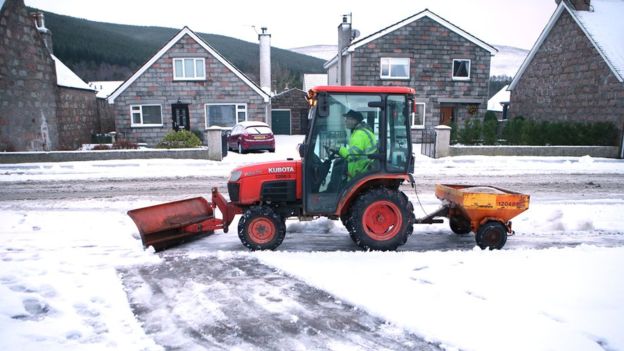Flood threat as snow and wintry weather grip UK
Fri 13 Jan 2017, 20:22:03

Severe flood warnings are in place on the eastern coast of England amid fears thousands of homes are at risk, as snow and strong winds hit much of the UK.
The Environment Agency, which says high tides and strong winds could lead to flooding, has issued severe flood warnings - meaning danger to life.
Evacuations are under way in Jaywick, Essex, and Great Yarmouth, Norfolk.
Snow, ice and high winds have affected much of the UK, causing travel problems and schools closures in some areas.
It comes as the Met Office has warned of high winds, snow and ice on Friday.
The Environment Agency's severe flood warnings - its highest possible alert - are in place for coastal areas of Essex, Norfolk and Suffolk, where there are fears there could be a storm surge.
More than 80 flood warnings - meaning immediate action is required - and more than 50 flood alerts are also in place.
The agency says high tide levels - due to spring tides and a tidal surge - combined with gale force winds will cause "large waves and sea spray resulting in potential damage to flood defences and flooding of property".
High tide is due in many areas at about 21:45 GMT.
Environment Agency chief executive Sir James Bevan told BBC Radio 4's Today programme the first tide to hit the coast on Friday was "slightly under the height that we expected".
"The second, due this evening, may come out slightly higher than has been anticipated," he added.
"And so we will stay very active throughout the day on the ground, we will continue to warn and inform the communities that are at risk."
Army on standby
In Essex, officials say about 2,500 homes and properties could be affected by flooding.
Essex Police said residents in Jaywick, Mistley and West Mersea, near Clacton-on-Sea, should "comply with police instructions" and evacuate their homes "immediately".
The risk had moved from the morning high tide to the evening tide, which was expected at midnight, Ch Insp Russ Cole added.
He said the force hoped to complete an evacuation in "daylight hours".
Leaflets, delivered to residents on Friday morning, warned people their properties "could be
flooded by sea water up to a depth of three metres".
flooded by sea water up to a depth of three metres".
Residents in approximately 5,000 properties in near Great Yarmouth have also been told to leave their homes, police said. The number of properties affected could rise to 7,000, officers added.
Meanwhile, the Suffolk Resilience Forum said there are about 1,880 properties at high risk of flooding in the county.
Elsewhere in the UK:
Up to 7in (18cm) of snow has fallen in Scotland, with 19 schools and 10 nurseries closed
RAF Sentinel surveillance aircraft will fly over Lincolnshire later to check for damage to flood defences. Several schools in the county are also closed
Friday morning's high tide passed Scarborough, Bridlington, Hull and Skegness without incident, the Environment Agency said
Some flights at Manchester Airport have been delayed while staff de-ice aircraft
Eurostar cancelled two trains between London and Paris due to "weather conditions" in south-east England and northern France
Further up the coast, the Ministry of Defence said about 100 soldiers from the Catterick army base had been deployed to Skegness, Lincolnshire, where about 3,000 residents have been urged to leave their homes or move upstairs.
The Environment Agency said it had moved more than five miles (8km) of temporary barriers and 25 pumps to depots and towns along the east coast.
Floods minister Therese Coffey said: "Our absolute priority is protecting lives, homes and businesses from the threat of coastal flooding currently facing the east coast."
The flood warnings follow wintery weather on Thursday across large parts of the UK.
In Scotland, snow has caused disruption on the roads. The A93 has been closed south of Braemar, while speed restrictions are in place due to high winds on the Forth Road Bridge and the Skye Bridge.
What is a storm surge?
A storm surge is a change in sea level that is caused by a storm.
The main cause of a storm surge is high winds pushing the sea water towards the coast, causing it to pile up there.
The strong winds in the storm generate large waves on top of the surge which can cause damage to sea defences, or spill over the top adding to the flood risk.
No Comments For This Post, Be first to write a Comment.
Most viewed from International
Most viewed from World
AIMIM News
Latest Urdu News
Most Viewed
May 26, 2020
Can Lionel Messi's visit boost Indian football?
Latest Videos View All
Like Us
Home
About Us
Advertise With Us
All Polls
Epaper Archives
Privacy Policy
Contact Us
Download Etemaad App
© 2026 Etemaad Daily News, All Rights Reserved.





































.jpg)
.jpg)
.jpg)


